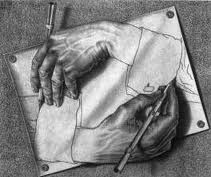Wednesday, February 8, 2012
The Statement I Am Now Making Is A Lie—True Or False
Judgment Day Conversation Continues
"Where did you get the idea for the X/Y form, anyway?" responded MV.
"That’s kind of a long story," I said. "Surprisingly, I’m sure Sartre’s
philosophy had a lot to do with it. I never liked Sartre or his
philosophy, it was too abstract, too empty, but without it, I
probably never would have discovered the X/Y form. Sartre’s for-itself
philosophy followed naturally from the X/Y form—it is a product of the
X/Y form.”
"Wasn't the `form' about logic and levels?" said MV.
"Well, yes, but it's even more about negation," I responded,
"the negation that constitutes Sartre's for-itself. From
there, I guess, the idea more or less fell out of the self-referential
paradoxes. When definitions for particular entities relate back to the
entity group to which the entity belongs, self-referential paradoxes
result. The definitions that fall into that category of paradox are
called self-referential concepts or relationships. Here are a few
examples:
["By way of introduction to Russell's antinomy, note that a set or
collection of objects may or may not have the character of these
objects. For example, a group of horses is not a horse and a group of
people is not a person. But in some cases a set of objects does have
the character of the objects. For example, a set of numbers may itself
be a number. As another example, the set of all sets may be
considered to be a set. In other words, a set may or may not be a
number of itself. Thus, the set of all horses is not a member of
itself where as the set of all sets is a member of itself. Consider
now the set, denoted by S, of all sets that are not members of
themselves. Is S a member of itself or not? Suppose S is a member of
itself; then (by definition of S) S is not a member of itself. Suppose
S is not a member of itself; then (by definition of S) it is a member
of S. Hence we arrive at the contradiction that S is a member of S if
and only if S is not a member of S. This is known a Russell's antinomy
and is an example of a set-theoretic antinomy…
In a similar illustration, consider the chief (or high priest) of a
tribe who makes sacrifices for those and only those members of the
tribe who do not make sacrifices for themselves. Does he make a
sacrifice for himself? If he does, then he does not; and if he does
not, then he does… (And lastly), another well-known antinomy concerns
a liar. For example, suppose a person says, "This statement I am now
making is a lie." Is the quoted statement true or false? It can be
shown that it can be neither, without involving a contradiction."
(Luchins and Luchins, 1965, p.13).]
“I need a little help here; where is the X/Y form in any of this,” said MV.
“The X/Y form,” I replied, “may be thought of as the pre-condition for
self-reference to occur. In fact, self-reference may be thought of as a product of
the X/Y form. But I am getting ahead of myself here. The original idea that
there was a pre-condition for self-reference was developed in the symbolic logic
of C.I. Lewis. To avoid contradictions such as occur in the Liar and other paradoxes, Lewis developed what he called pragmatic contradiction. It, pragmatic
contradiction, treats together the speech and the act of speaking.
‘All statements are false’ cannot be true because it implies, not a
restriction against self-reference as Russell said, but because it
implies the necessary truth of the contradictory opposite, ‘There
exists at least one true statement.’ Starting with a
contradiction-free affirmation, the structures of knowledge can then
be made to follow in a necessary and systematic fashion. In this way,
the closed system problems that arise in mathematics are avoided.
Trying to locate the foundation of this knowledge—the source of
rule-generated information--was what led me to the idea of the X/Y form."
Subscribe to:
Post Comments (Atom)







No comments:
Post a Comment